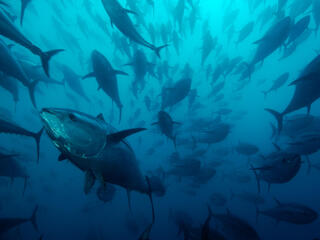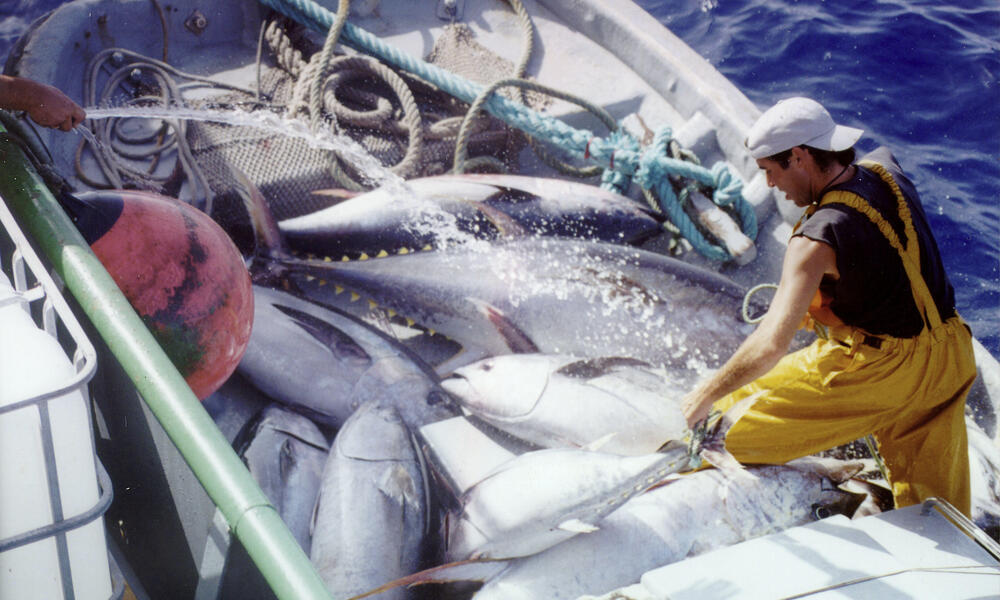If fish were like cars, tuna would be the Ferraris of the ocean—sleek, powerful, and made for speed. Their torpedo-shaped bodies streamline their movement through water, and their special swimming muscles enable them to cruise the ocean highways with great efficiency.
Tuna are remarkable and impressive wild animals. The Atlantic bluefin can reach ten feet in length and weigh as much as 2000 pounds (more than a horse). Their specialized body shape, fins and scales enable some species of tuna to swim as fast as 43 miles per hour.
Tuna swim incredible distances as they migrate. Some tuna are born in the Gulf of Mexico, and travel across the entire Atlantic Ocean to feed off coast of Europe, and then swim all the way back to the Gulf to breed.
These extraordinary marine animals are also integral to the diet of millions of people and are one of the most commercially valuable fish. The majority of the market is made up of four species: skipjack alone account for more than half of the global catch of tuna, followed by yellowfin, bigeye, and albacore. The critically endangered bluefin tuna only makes up 1% of the global catch. As the methods of catching tuna have advanced over the years, the conservation and management of tuna has not evolved as quickly. According to the United Nations Food and Agriculture Organization, most tuna stocks are fully exploited (meaning there is no room for fishery expansion) and some are already overexploited (there is a risk of stock collapse). According to the International Seafood Sustainability Foundation, 65% of tuna stocks are at a healthy level of abundance, but 13% are considered overfished.

 Albacore Tuna
Albacore Tuna
 Bigeye Tuna
Bigeye Tuna
 Bluefin Tuna
Bluefin Tuna
 Yellowfin Tuna
Yellowfin Tuna
 Skipjack Tuna
Skipjack Tuna




 Vishwanie Maharaj
Lead, Tuna and Multilateral Fisheries
Vishwanie Maharaj
Lead, Tuna and Multilateral Fisheries
 Sea Turtle
Sea Turtle
 Vaquita
Vaquita
 Whale Shark
Whale Shark
 Dugong
Dugong
 Humphead Wrasse
Humphead Wrasse
 Pacific Salmon
Pacific Salmon
 Dolphins and Porpoises
Dolphins and Porpoises
 Whale
Whale
 Seals
Seals
 Sea Lions
Sea Lions
 Marine Iguana
Marine Iguana
 Sei Whale
Sei Whale
 Hawksbill Turtle
Hawksbill Turtle
 Great White Shark
Great White Shark
 Loggerhead Turtle
Loggerhead Turtle
 Leatherback Turtle
Leatherback Turtle
 Green Turtle
Green Turtle
 Olive Ridley Turtle
Olive Ridley Turtle
 North Atlantic Right Whale
North Atlantic Right Whale
 Blue Whale
Blue Whale
 Fin Whale
Fin Whale
 Bowhead Whale
Bowhead Whale
 Gray Whale
Gray Whale
 Hector's Dolphin
Hector's Dolphin
 Galápagos Penguin
Galápagos Penguin
 Shark
Shark
 Polar Bear
Polar Bear
 Narwhal
Narwhal
 Beluga
Beluga
 Giant Tortoise
Giant Tortoise
 African Wild Dog
African Wild Dog
 African Elephant
African Elephant
 Black Rhino
Black Rhino
 White Rhino
White Rhino
 Rhino
Rhino